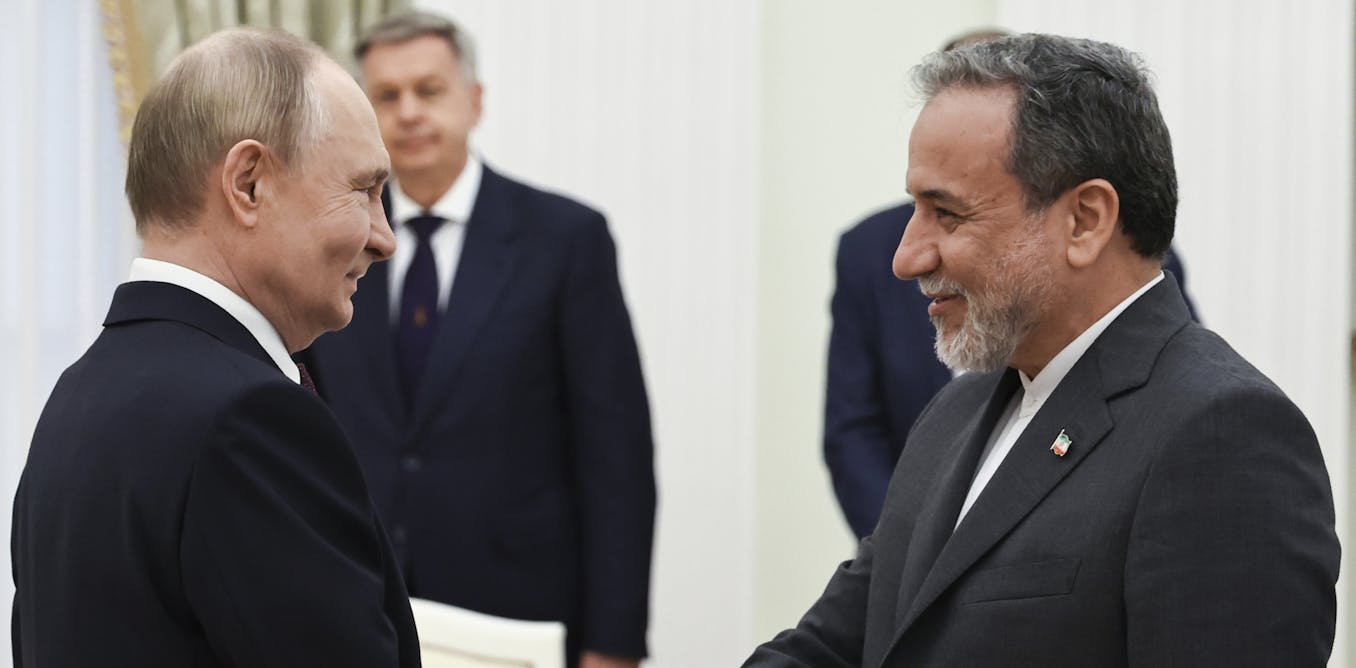If Iran preserved its nuclear stockpile of fissile material, it has more incentive to develop a nuclear weapon, despite the damage Israel and the United States did to its production facilities. This is especially true if the damage to facilities like Fordow was less than Trump is proclaiming.
Russian-Iranian relations
While the future of Iran’s nuclear weapons capacity remains unknown, what is clear is that the U.S. and Israel were able to strike at Iran in large part due to Russia’s ongoing war in Ukraine.
In the modern era, relations between Russia and Iran have frequently been tense. Russia and the Soviet Union’s interests in the region have provoked several conflicts, most notably during the 1940s when the Soviets encouraged the formation of the People’s Republic of Azerbaijan on Iranian soil.
The shah of Iran’s close relationship with the U.S. further discouraged a strong relationship between Moscow and Tehran.
The shah’s fall and the collapse of the Soviet Union, however, allowed for a working relationship to develop between Iran and Russia. They’re still rivals but nevertheless work together when it suits their best interests. Russian and Iranian co-operation on the Syrian civil war is an example.
Furthermore, both Iran and Russia have provided diplomatic support for each other. Russia’s insertion into the Iran nuclear deal framework in 2015 benefited both parties. It provided economic benefits to Russia, and it also allowed Iran to develop its nuclear ambitions.
When Russia invaded Ukraine in 2022, Iran was one of the few countries that didn’t oppose the move. It abstained from voting on a United Nations resolution in March 2022 condemning Russia’s aggression against Ukraine, which amounted to tacit support.
More importantly, Iran’s own success in evading oil sanctions helped Russia do the same, allowing the Russians to maintain their war effort in Ukraine.
The connections between Russia and Iran, however, goes beyond the political and economic.
Drones and other weapons
Iran has played a pivotal role in Russia’s war in Ukraine. One of Ukraine’s initial advantages was in drone technology, including the drone expertise of its allies. The Russian military, which had not fully embraced the implications of drone technology, was at a severe disadvantage.
Iran, however, had embraced the role of drones in warfare and both provided drones to Russia and helped the Russians develop their own domestic production.
Iran, at an arms disadvantage against Israel and the U.S., sought to use drones to offset this weakness. The Iranians, in fact, pioneered the use of drones, most notably the Shahed 131 and 136.
Before Russia’s invasion of Ukraine, however, the flow of weapons between Russia and Iran was more one-sided. Since the collapse of the Soviet Union, Iran has been a vital market for Russian military technology. Russian leaders have viewed the sale of weapons to Iran as both a way of supporting the Russian economy and to counter American interests in the Middle East.
So what’s all this have to do with Ukraine?
Iran left open to bombardment
The most crucial weapon provided by Russia to Iran is arguably the S-300, an advanced surface-to-air missile systems.
Israel’s air dominance and its ability to overcome Iranian air defences in the past meant that the S-300 was a vital piece of technology for Iran. Israeli officials recognized the S-300’s importance to countering their operations when they, for several years, used political pressure to block S-300 sales to Iran.
In October 2024, Israel likely breached the software that operates the S-300, disabling the system’s radar. This breach allowed Israel to eliminate Iran’s S-300s, and left Iran vulnerable to Israeli and American air attacks.
Iran has been unable to acquire replacements for one simple reason: Russia needs the weapon systems in Ukraine. Ukraine has prioritized eliminating Russian air defences like the S-300.
The enduring Ukraine-Russia conflict has served as a bleeding ulcer for the Russian armaments industry. Russian military hardware has been destroyed at such a rate that it’s delayed Russia’s sale of weapons to key markets, including Iran and India.
The situation has caused Indian Prime Minister Narendra Modi to pivot away from Russian military technology — a key feature in Russian-Indian relations — for domestic arms backed by western technology.
Iran, meantime, has been left open to aerial bombardment by Israel and the U.S.
Although Iran reportedly possesses the even more advanced S-400, this hasn’t been confirmed and Iran has denied it.
Ukraine advances U.S. interests
Rightly or wrongly, the U.S. government identified bombing Iran alongside Israel as being in its national interest. But it’s unlikely American involvement would have been possible without Ukraine draining Russian resources.
The problem is that the current U.S. administration views the world and its events in an isolated manner. But in a globalized world, few events remain in isolation.
The U.S. government may argue that supporting Ukraine is not in American interests, but Ukraine’s ongoing fight against Russia is actually assisting Americans elsewhere — most notably, in Iran.
This article written by James Horncastle, Assistant Professor and Edward and Emily McWhinney Professor in International Relations, Simon Fraser University and is republished from The Conversation under a Creative Commons license. Read the original article.




